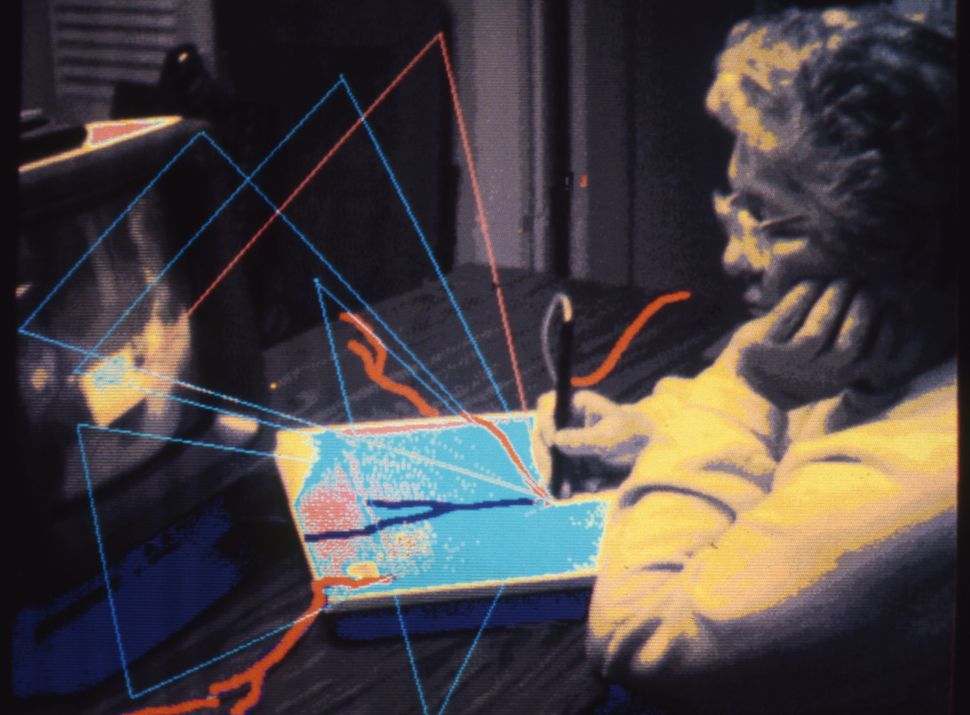Sonia Landy Sheridan’s “Drawing in Time,” showing a seated person holding a pen while colorful digital overlays in blue, red, and orange lines intersect the image, blending analog and digital art.” width=”970″ height=”715″ data-caption=’Sonia Landy Sheridan, <em>Drawing in Time</em>, 1982-83. <span class=”lazyload media-credit”>The Daniel Langlois Foundation Collection of the Cinémathèque Québécoise. Sonia Landy Sheridan fonds. Photo Cinémathèque Québécoise</span>’>
Brion Gysin thought big. Not content with the new generation of television sets that were landing in homes across the Western world, in 1958, the late British-Canadian artist and writer invented his Dreamachine, a rotating cylinder with lights inside created in consultation with his friends William Burroughs and electronics whizz Ian Somerville. The idea was that a viewer would sit in front of the Dreamachine and close their eyes. As it spun around (either at 45 or 33 RPM—it sat on a record turntable), the machine’s flickering lights would somehow evoke patterns in the viewer’s mind. Gysin had hoped the contraption would replace the television as the international go-to entertainment system, but time, technology and the fact that people can’t see with their eyes shut worked against him. Nonetheless, Gysin’s aptitude for thinking outside the box fits neatly into “Electric Dreams” at London’s Tate Modern, where more than 150 artworks have been brought together to show how artists utilized machine technology in the pre-digital age between the 1950s and the arrival of the internet in the late 1980s.
Dreamachine is on show here, along with Alberto Biasi’s 1962 piece, Light Prisms, a cubic tray of rotating shapes that manifest bewitching spectral colors as they turn, like a kinetic preemptive take on the cover of Pink Floyd’s Dark Side of the Moon. Otto Piene’s Light Room (Jena) also plays with electrical illumination. A founder member of Zero, the experimental German art collective that embraced new technology after World War II, his Light Room is—literally—a darkened room bejeweled with constellation-like pinpoints. Imagine gazing into a neatly organized night sky. The exhibition’s earliest pieces are Tanaka Atsuko’s paintings inspired by her Electric Dress, an assemblage of neon tube lights and light bulbs from 1956.
From the Seventies, Carlos Cruz-Diez’s Environnement Chromointerférent is an iteration of the Venezuelan artist’s spaces devoted to optical art, the process of using color and geometry to create artworks that look like they’re in motion. Meandering between the suspended spheres and blocks in his room is pleasingly psycho-dramatic as projected colored stripes appear to tilt and shift. The AARON in Harold Cohen’s AARON #1 Drawing from 1979 is a computer program of Cohen’s own invention and an early attempt at creating art using artificial intelligence. AARON suggested lines, forms and squiggles that Cohen then used to create paintings.
SEE ALSO: When Human Creativity Meets Technical Autonomy – An Interview With Artist Anna Ridler
The arrival of commercial computers and video games in the 1980s provided artists with more zones of exploration. In 1985, Eduardo Kac used a Minitel terminal (an early precursor of internet communication) to send a message to his girlfriend. His boxy coded web pages spell out the word tesão, a Portuguese slang word for horny. In the mid-eighties, Samia Halaby got hold of a Commodore Amiga 1000 PC in a fire sale and began tinkering with its ability to throw up lines and swirls for experiments in burgeoning digital art. Her Spooling Up 4 and Fold 2 images are here, both fizzy celebrations of pixelation. Sonia Landy Sheridan already had form in pushing new technology in creative directions, and her work from the decade included using photocopiers to take selfies. Overlaid with software-generated marks, the results could easily come from one of those cable TV programs about ghost hunting.
Suzanne Treister grabbed video gaming by the lapels, and there are still photos from her Fictional Videogame series. Treister was using the Deluxe Paint II graphic software to stretch the limits of fantasy imaging in gaming as the Nineties approached. Liliane Lijn’s The Bride from 1988 glowers in the shadows. Lijn built a number of installations based on the myth of Inanna, the ancient Sumerian goddess who traveled to the underworld and returned to the Earth’s surface, triumphant and unscathed. Lijn’s Inanna pulsates in a caged temenos, the consecrated space in front of early temples where all worshippers could feel safe. While Treister’s pieces are as Eighties as Alexis Colby’s shoulder pads, The Bride feels timeless.
Monika Fleischmann and Wolfgang Strauss call their Liquid Views project a digital well, the kind of watery mirror used by Narcissus. The Narcissus in the piece’s equation is the media and how we use it to reflect on reality. It’s a touchscreen device from 1992, and visitors can poke and prod the surface to create pooling, globular images of themselves. Tatsuo Miyajima has a room of his own for Lattice B, an eight-meter-long installation of LED lights (from 1991), and Opposite Circle (1990). Both are experiments in Miyajima’s mind-boggling mathematical theories he invented to meditate on Buddhist cyclic notions of reincarnation, and their old-school calculator-like numbers flash in unending groups and configurations.
One key success of “Electric Dreams” is how it reinforces how technological advances have always been a source of interest to artists, from Leonardo da Vinci’s experiments with flying machines and Canaletto’s purported use of the camera obscura to the contemporary creatives currently trying to work out the benefits of artificial intelligence. Plus, nostalgia is big business these days, with the wonder of retro video games and toys, the revival of the vinyl record and the recasting of past fashions hailed as ironic and iconic. “Electric Dreams” plugs into a summation of these curiosities, satisfying our indefatigable wish to look back at what might seem like simpler times along the way.
“Electric Dreams: Art and Technology Before the Internet” is at Tate Modern in London until June 1, 2025. Advanced booking is advised.

